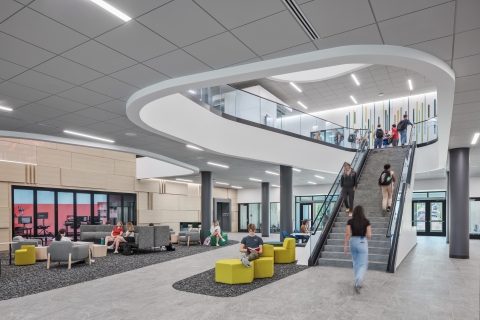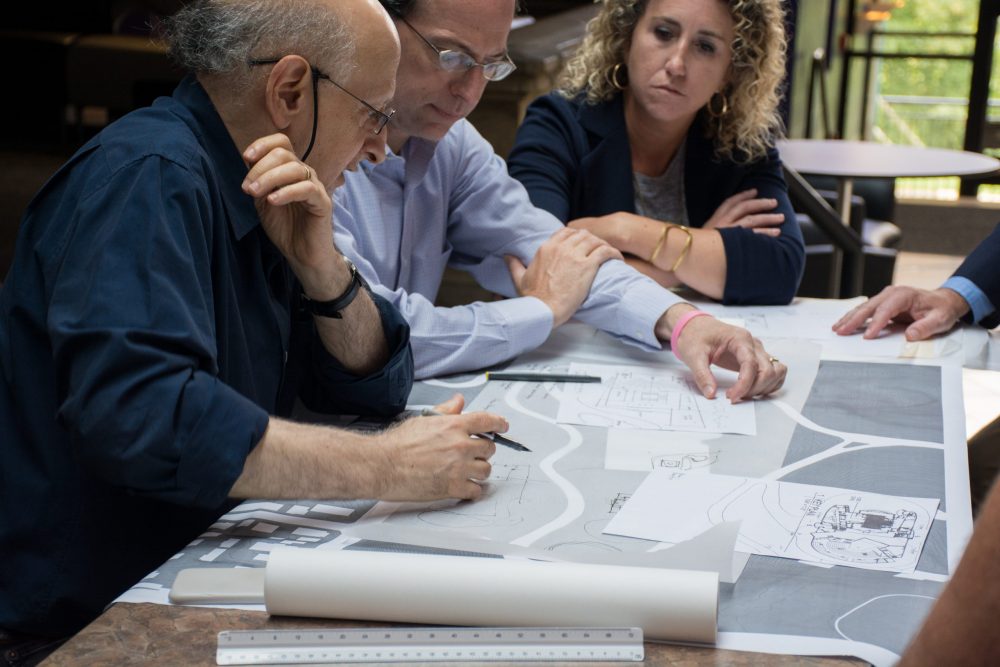
Creating Inspiring Experiences Through Purposeful Design
by Tom Arends and Samantha Delabar
When leveraging purposeful design through a balanced approach of informed, empathetic, and exciting, designers can reach a higher, more impactful level of design.

Engaging with the client to incorporate relevant knowledge at every step is the key to purposeful design.
Winston Churchill said, “We shape our buildings; thereafter they shape us.” Purposeful design builds on this quote by creating a novel problem-solving approach that inspires people, enhances experiences, and drives strategic results. This new design approach leverages the strengths and key ideas of design thinking as well as experiential and emotional design to positively impact the environments and behaviors within a space. The three key principles of purposeful design are centered on intent, people, and emotion—all of which deliver a more informed, empathetic, and exciting design solution. Armed with a deeper understanding of people, their behaviors, and feelings, designers can generate positive improvements on the effectiveness of work environments, while helping to enhance business results for their clients.

Understanding Purposeful Design
Purposeful design takes a holistic look at all aspects of design including the people, the organization, and other key influences through a collaborative exchange of information. This process occurs prior to putting pen to paper. Designers’ personal assumptions and perceptions for the final solutions are tempered by including valuable insights comprised of the users’ needs, aspirations, and journeys within the design. This method ensures that the final design of the space feels as though it was created expressly for the people interacting within the environment. To better illustrate this principle, picture a tripod. Each of the three purposeful design components function like the legs of a tripod to provide balance and a solid foundation for impactful design. These three principles may shift and adjust to accommodate different situations and conditions. However, if one is eliminated, the final design may not achieve its full potential. When all three principles are incorporated, they produce a more successful and powerful solution that inspires the users of the space, meets their needs, and aligns with the organization’s goals. This approach has unique implications for the future of workplace design.
The First Principle: Informed
Informed design is intentional, focused, and driven by awareness, information, and data. It refers to the iterative practice of extracting, distilling, and leveraging ideas, research, and information to help formulate design solutions. Analyzed data can help expose problems, provide more information about those problems, and evaluate the effectiveness of solutions. According to Design Blog Editor Cameron Chapman, “Collecting and analyzing data is key to creating better designs and user experiences.” Through the process of gathering and analyzing, designers should incorporate a full range of both qualitative and quantitative data types early and throughout the process. Strategic data incorporates softer data, including the vision, leadership’s goals, and success criteria of the project and organization. Spatial data includes not only “hard” data, which is the quantitative information on where, when, and how people spend their time, but also “soft” data which is the qualitative or more subjective perceptions of how people’s time was spent in specific spaces. Data focusing on the building’s performance and human comfort such as temperature, humidity, and light, is considered environmental data, while business data assists designers in understanding their clients’ work processes and workflow.

Informed: Understand businesses & organizations
After determining the right types of data to use, the next step is to select the data streams needed to capture this critical information. Sensors, badge readers, spatial observations, and employee surveys indicate who is using the space and how the space is being used. Interviews, visioning sessions, and other specialized activities can be used to gain more insights from the people who will occupy the new spaces. Designers can review existing research, articles, and lessons learned from similar projects to provide additional data on applying best practices for designing the space.
“Collecting and analyzing data is key to creating better designs and user experiences.”
– Cameron Chapman, Design Blog Editor
This wider spectrum of inputs, once filtered and analyzed, provides a strong influence on a proposed design direction. The challenge is recognizing what data is required and asking the right questions to avoid the process from becoming overwhelming. Quantitative data can drive optimization and efficiency while qualitative data is required to address “softer” inputs, allowing for a more balanced solution. The wider the data net is cast, collected, analyzed, and applied, the more informed the design becomes. In this process, data leads to knowledge and knowledge leads to wisdom. The currency of this wisdom allows the final design solution to achieve a more meaningful and effective result. Ultimately, purposeful design blends and balances objective content with subjective content.
The Second Principle: Empathetic
Empathy is the ability to understand and share the feelings of other people. More than ever before, designing for people requires an empathetic mindset that addresses the need to better comprehend people, to be sensitive to the feelings and needs of others, and to use that ability to tap into an individual’s strengths. Whether it is seeing through their eyes or walking in their shoes, gaining a better understanding of a user’s emotional needs helps designers set aside preconceived notions. In fact, companies that incorporate empathy and emotional intelligence in their corporate culture outperform their rivals by 20 percent. Additionally, a 2019 survey determined that 91 percent of CEOs surveyed believe that empathy can improve productivity, motivate employees, and affect a company’s financial performance. Designing a memorable user experience requires understanding the characteristics of the people who will be using the space and what inspires them. This principle helps bring valuable insights into the challenges that can be solved with purposeful design.

Empathetic: Understand people and behaviors
Equally important is recognizing the psychological affects the space may have on users as aspects of the space can affect a user’s mood, safety, and wellbeing. Consider the following three types of empathy when using purposeful design. First, cognitive empathy represents a user’s thoughts, understanding and intellect. This type of perspective thinking responds to problems with brainpower, such as when finding ways to motivate coworkers. Second, emotional empathy represents the user’s feelings and physical sensations and helps with interpersonal relationships. Finally, compassionate empathy represents the user’s intellect, emotion, and the need to help or respond. Compassionate empathy works to strike a balance between cognitive and emotional empathy. The combination and consideration of these three types of empathy allows the designer to connect with the end user in a deeper way, resulting in design solutions that support and inform positive behaviors.
“Gaining a better understanding of a user’s emotional needs helps designers set aside preconceived notions.”
Engagement activities, such as understanding personas and journey mapping of those who will use the space while becoming immersed in the culture of the organization, should be conducted with the users of the space to deepen the designers’ connection to the target audience. Incorporating the empathetic principle into the design process allows designers to set aside their own assumptions and opinions and view the design solution from the user’s point of view.
The Third Principle: Exciting
Beyond understanding people, tapping into what engages and excites them is another important element of purposeful design. The principle of exciting taps into the emotion of the end game, which reflects how people see, feel, and interact in a newly designed or renovated space. This principle is responsible for creating a positive and memorable experience for the user by eliciting an appropriate emotional response. According to Don Norman, Director of the Design Lab at the University of California, San Diego, there are three levels of emotional design that can impact and influence design and design thinking. The visceral level is a natural, automatic response and encompasses first impressions and what can be referenced as “curb appeal.” Incorporating this level into design reflects the user’s feelings and the initial reaction to the space’s attractiveness. The behavioral level represents a user’s reaction to the space, how the space support’s the user’s functional needs, and how the user feels during the experience. This component of emotional design helps designers to enhance the functional effectiveness and usability of the space. The reflective level is how a user remembers the experience of being in the space. Integrating the reflective level into the design of a space incorporates the impact of thought and meaning as well as the shareability of the experience with others.

Exciting: Understand emotions and feelings
These emotional design levels involve both subconscious and conscious responses to help determine what is important and creates a balance between functional solutions with delightful ones. A user’s senses play a role in how an experience is perceived and can trigger memories of a space or place the user visited. The senses have a strong and connected influence on emotions which allows users to find excitement in the spaces they inhabit. Every experience has an emotional component connected directly through the senses which is why this principle is key in the design of space and environments.
Client Engagement
The common thread through every step of purposeful design is engaging the client and incorporating relevant knowledge along the way. When clients and end users of the environments are involved in the process, they will have a stronger connection to the design solutions because they were active participants in creating the vision, co-creating potential solutions, and actively developing the design direction. With the trust that was built through the process, they will feel empowered and more familiar with the solutions since they recognize the spaces were designed specifically for their needs. The purposeful design approach is unique because every design project is unique. The right solution for one space will not be the best solution for another space as companies, their people, and their problems are all different.
Designers seeking a more empathic approach in creating inspiring spaces should consider integrating the problem-solving techniques of purposeful design into their creative process. When leveraging purposeful design through a balanced approach of informed, empathetic, and exciting, designers can reach a higher level of design which more effectively impacts people and drives business results.
This article was originally published on Work Design Magazine. If you’re interested in reading more about building a working relationship with clients, check out “Constructing Client Relationships.”
Author


